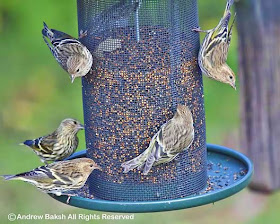On Saturday, we began our bird walk by first scanning the parade grounds at
Van Cortlandt Park in the Bronx NY. We focused on the enclosed area since a casual glance at the surrounding areas did not show any of the usual flock of Canada Geese feeding. Alex Pirko, one of our regulars arrived and informed the rest of us that he had seen a
Killdeer (Charadrius vociferus) while crossing the parade grounds. This was a new bird for the year at Van Courtlandt Park, so I took the group to look for the bird. As we made our way onto the field, small groups of Canada Geese began to fly in from the VC lake and in one such group, I spotted our local star. The
Greater White-fronted Goose; unfortunately, the bird did not land and instead chose to fly over the field heading in a south easterly direction until it dropped out of sight. We speculated that it may have worked its way toward the golf course.
By then, we were joined by Arthur and Rose who I found out to be new birders. Our regulars made them felt right at home with the group and it was not long before Arthur and Rose began picking up life birds. We continued working the parade grounds and found the
Killdeer hunkered down in the grass trying to be as inconspicuous as possible. Everyone had good looks and it was nice to see Arthur and Rose get their life Killdeer.
From the parade grounds, we immediately went to the small bridge near the golf course and picked up another new year bird for Van Courtlandt, in
Green-winged Teal (Anas crecca). A drake that provided a nice look at size comparison with the Mallards in tow. We spent quite a bit of time in this area as other birds made their presence known. We were treated to great looks at
Rusty Blackbirds (Euphagus carolinus) and Red-winged Blackbirds (
Agelaius phoeniceus). With the
Red-winged Blackbirds and
Carolina Wrens (
Thryothorus ludovicianus) singing, it felt like Spring.
As much as I would have liked to stay in the area, we had to move on, so I took the group up into Vault Hill where we looked for the
Eastern Phoebe that was reported last week by birder/naturalist Tom Fiore, but for the second week in a row we could not find that bird. Since it was such a nice day, I decided to take the group into the North Woods; the hike into the North Woods is a long one, but the group were up to the task and we birded along the way. Our best bird in the area was a
Great Horned Owl (Bubo virginianus) that "found us". The GHO was a first for our walks and it was disappointing that most in the group only had "flying away" looks. A deviation off the main trail checking out potentially birdy looking habitats did not yield much, but we did pick up
Golden-crowned Kinglet (Regulus satrapa), a bird that I had heard earlier on the trail. 2
Brown Creepers (Certhia americana), made a brief appearance then were gone. We had the usual assortment of Woodpeckers and other smaller passerines, but no surprises. Arthur and Rose who had kept up with the group despite the long trek, decided to leave and the rest of us kept on birding. We eventually made our way back out of the North Woods where we saw Arthur and Rose taking a break. They reported having good looks at male
Downy Woodpecker (Picoides pubescens); I was impressed and pleased that despite feeling tired, they kept on birding on the way out. For new birders they were off to a great start!
The rest of us took the steep trail back into Vault Hill where again we poked around looking and listening patiently for anything that would give away the presence of an
Eastern Phoebe, but we came up empty. From Vault Hill we made our way back across the parade grounds where I scanned the flock of Geese for the
Great White-fronted Goose, but it was not there. It did not help that many folks blatantly had dogs off leash running around chasing those Geese which had dared to venture out on the open field. I was rather disappointed seeing this behavior especially since the ranger station was right next to the parade grounds.
I ended the walk shortly thereafter at the restoration area. In all we saw a total of 38 species.
American Crow (Corvus brachyrhynchos)
Mute Swan (Cygnus olor) 2
Gadwall (Anas strepera) 2
American Black Duck (Anas rubripes) 3
Mallard (Anas platyrhynchos) 19
Green-winged Teal (Anas crecca) 1
Hooded Merganser (Lophodytes cucullatus) 2
Ruddy Duck (Oxyura jamaicensis) 3
Mourning Dove (Zenaida macroura) 6
Belted Kingfisher (Megaceryle alcyon) 1
Red-bellied Woodpecker (Melanerpes carolinus) 2
Downy Woodpecker (Picoides pubescens) 1
Blue Jay (Cyanocitta cristata) 4
Black-capped Chickadee (Poecile atricapillus) 4
Tufted Titmouse (Baeolophus bicolor) 3
Carolina Wren (Thryothorus ludovicianus) 2
White-throated Sparrow (Zonotrichia albicollis) 8
Northern Cardinal (Cardinalis cardinalis) 3
Red-winged Blackbird (Agelaius phoeniceus) 5
Rusty Blackbird (Euphagus carolinus) 6
House Finch (Carpodacus mexicanus) 7
American Goldfinch (Spinus tristis) 5
House Sparrow (Passer domesticus) 26
Song Sparrow (Melospiza melodia) 2
Great Horned Owl (Bubo virginianus) 1
White-breasted Nuthatch (Sitta carolinensis) 3
Brown Creeper (Certhia americana) 2
Golden-crowned Kinglet (Regulus satrapa) 1
American Robin (Turdus migratorius) 1
European Starling (Sturnus vulgaris) 6
Dark-eyed Junco (Junco hyemalis) 14
Greater White-fronted Goose (Anser albifrons) 1
Canada Goose (Branta canadensis) 345
Killdeer (Charadrius vociferus) 1
Ring-billed Gull (Larus delawarensis) 2
Herring Gull (Larus argentatus) 4
Rock Pigeon (Columba livia)
Hairy Woodpecker (Picoides villosus)
Tags:
 Van Cortlandt Park
Van Cortlandt Park,
 Bronx NY
Bronx NY






































